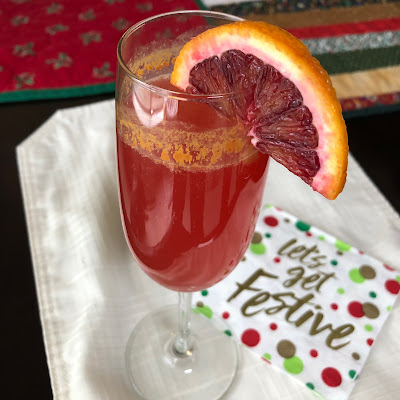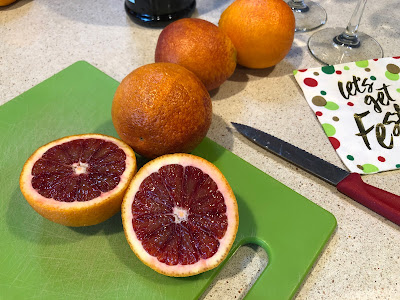
Recipe: Blood orange mimosa completes a festive brunch

How pretty is this? Blood orange juice is a special
addition to this mimosa. Pulp in the juice creates
the decorative ring when the sparkling wine is added. (Photos: Kathy Morrison) |
More gray, more rain. Little things help brighten the winter days. If you're hosting a brunch, or just fixing breakfast for two, a mimosa is a lovely addition to the menu.
I took the citrus element one step further by using blood orange juice. Blood oranges are a little smaller and a littler tarter than navel oranges, but they produce gorgeous reddish-purple juice and the prettiest beverage this side of a Shirley Temple. And make the version with sparkling cider if you want a nonalcoholic cocktail; the simple syrup and orange liqueur are both optional with that one.
Make a simple syrup quickly to lightly sweeten the tartness: Mix 2 tablespoons granulated sugar and 2 tablespoons tap water in a Pyrex measuring cup. Microwave for 1 minute on HIGH. This produces simple syrup for several servings of this drink.
Blood orange mimosa
Makes 1 serving
Ingredients:
Juice of 1/2 a blood orange, about 1-1/2 tablespoons juice
1/2 teaspoon simple syrup (see above)
1/2 teaspoon orange liqueur, such as Cointreau or Grand Marnier (optional)
Chilled Prosecco or another white or rosé sparkling wine, or nonalcoholic sparkling cider
Blood orange slice, for garnish

Instructions:
Strain the blood orange juice if desired. A regular wire mesh strainer will leave some pulp, as in the photo above; a fine mesh strainer will remove nearly all the pulp. (But don't strain it into the sink, as I did the first time!)
Pour the juice into a fluted glass. Stir in the simple syrup and, if using, the orange liqueur. Fill the rest of the glass with the sparking wine or cider. Add the garnish, and enjoy. Happy New Year!
Comments
0 comments have been posted.Sacramento Digs Gardening to your inbox.
Sites We Like
Garden Checklist for week of April 14
It's still not warm enough to transplant tomatoes directly in the ground, but we’re getting there.
* April is the last chance to plant citrus trees such as dwarf orange, lemon and kumquat. These trees also look good in landscaping and provide fresh fruit in winter.
* Smell orange blossoms? Feed citrus trees with a low dose of balanced fertilizer (such as 10-10-10) during bloom to help set fruit. Keep an eye out for ants.
* Apply slow-release fertilizer to the lawn.
* Thoroughly clean debris from the bottom of outdoor ponds or fountains.
* Spring brings a flush of rapid growth, and that means your garden needs nutrients. Fertilize shrubs and trees with a slow-release fertilizer. Or mulch with a 1-inch layer of compost.
* Azaleas and camellias looking a little yellow? If leaves are turning yellow between the veins, give them a boost with chelated iron.
* Trim dead flowers but not leaves from spring-flowering bulbs such as daffodils and tulips. Those leaves gather energy to create next year's flowers. Also, give the bulbs a fertilizer boost after bloom.
* Pinch chrysanthemums back to 12 inches for fall flowers. Cut old stems to the ground.
* Mulch around plants to conserve moisture and control weeds.
* From seed, plant beans, beets, cantaloupes, carrots, corn, cucumbers, melons, radishes and squash.
* Plant onion sets.
* In the flower garden, plant seeds for asters, cosmos, celosia, marigolds, salvia, sunflowers and zinnias.
* Transplant petunias, zinnias, geraniums and other summer bloomers.
* Plant perennials and dahlia tubers for summer bloom.
* Mid to late April is about the last chance to plant summer bulbs, such as gladiolus and tuberous begonias.
* Transplant lettuce seedlings. Choose varieties that mature quickly such as loose leaf.